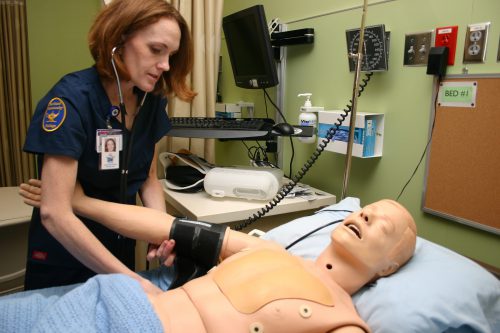This content was published: October 2, 2017. Phone numbers, email addresses, and other information may have changed.
Home to nursing and medical imaging, HT Building needs a comprehensive renovation
Photos and story by James Hill
As a nurse, Marilyn McGuire thinks it’s time to stop patching what ails Portland Community College’s Health Technology Building. It needs immediate surgery.
Hyperbole aside, Sylvania’s Health Professions division dean has a point. Her departments are located in the building, which, as one would expect of a structure built in 1972, has issues with plumbing and HVAC systems, and sports an archaic space layout for programs trying to serve a high-tech healthcare industry.
“We’ve been putting bandaids on gaping wounds and have become mired in a constant cycle of repairs that is trying to address the deterioration of the building,” McGuire said. “But the deterioration is winning.”
This November, PCC is putting a $185 million bond measure on the ballot that would, if passed, renovate and modernize the existing HT Building, which houses STEAM and health professions classrooms, as well as PE facilities and the Exercise Science program. This would include updated science and biology labs, nursing program and radiographic technology program education suites, and faculty workspace for all the programs housed in the facility.
“The walls around you really do impact how you work, and how students learn,” she said. “Having the opportunity to do an extreme HT Building remodel, that has teaching and learning as its focus, would be possible if the November bond passes.”The building houses the college’s health professions like Nursing, Medical Imaging, and Dental (Dental will be moving in 2020 to the new $100 million education and health center in downtown Portland, in a shared facility alongside the OHSU-PSU School of Public Health, PSU’s Graduate School of Education, and a City of Portland bureau).
But it’s the college’s Nursing Program that is the cornerstone of the building. The program is approved by the Oregon State Board of Nursing, nationally accredited by the Accreditation Commission for Education in Nursing, Inc., and is a member of Oregon Consortium for Nursing Education (OCNE). The nursing curriculum gives students the knowledge and skills required for an entry-level nursing job. It also qualifies them to take the National Council Licensure Examination for Registered Nurses, which is a requirement for practice and prepares them to be licensed registered nurses.
The Nursing Program has 11 full-time faculty and 11 part-time faculty, supplying local and regional healthcare facilities with talented nurses at a time when there’s a shortage. However, the building that houses them hasn’t changed with the times. The sturdy concrete walls and the amount of inflexible space in HT has made it hard to utilize their training equipment in both the Nursing and Medical Imaging labs to their fullest capacity.
“The Nursing Program’s skills and simulation labs are located on two different floors, which increases inefficiencies and missed synergies that could be expanded if they were co-located on the same floor,” McGuire continued. “The Medical Imaging labs located on the third floor currently do not provide enough room for the reading of diagnostic images, which reduces the effectiveness of those ‘learning’ moments students have with faculty.”
But the real issues are with the constant need for the college’s Facilities Management Services staff to repair leaks or address HVAC issues that affect student learning and interrupt faculty work.
“Just as in our own health, if we do not address issues that arise because of the passage of time, things start to fail – for HT that means pipes start to leak, equipment repairs increase, and issues that start to surface need immediate interventions,” she said. “This speaks to basic infrastructure, which is what’s happening in the HT Building.”
The building also is a center for physical education classes and includes the campus’ swimming pool, athletic facilities and the Exercise Science Program. But it’s the health professions industry programs and the Anatomy and Physiology labs that have the biggest challenges. Those challenges combined with infrastructure issues, and McGuire said it’s time to pull the plug on the HT Building, in its current state.
“The time spent addressing the building’s issues is time taken away from developing programs and curriculum that are positive for students and faculty – time away from what we could and should be doing,” McGuire cautioned.
“With a remodel opportunity, we have a chance to create teaching and learning environments that are student-focused and bring spaces up to a standard that enhances our ability to deliver the type of education that sends qualified professionals out into the healthcare arena,” she said.
What Would the Bond Do?
The PCC bond measure of $185 million would:
- improve workforce training programs to better align with current and future jobs.
- invest in training for Health and STEAM (Science, Technology, Engineering, Arts and Math) programs.
- upgrade safety, security, building longevity and disability access.
If passed, it is estimated to the tax rate of 40 cents per $1,000 of assessed property value for the next 16 years. Learn more about the bond!




I really value both swimming pools, I use them every term and the locker room is a great place to freshen up. I encourage other students to use the health facilities (the building can go easily unnoticed). I believe Sylvania is the only campus with a pool and it would be a shame if they were removed. Please keep the pools and the locker rooms.